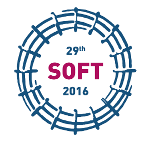Speaker
Alejandro Morono
(National Fusion Laboratory)
Description
Lithium density and tritium release behaviour are key properties in the design and synthesis of Li-containing solid breeders for the helium cooled pebble blanket (HCBP) concept. Radiation and high temperature may give rise to changes in both material composition and microstructure, hence important aspects including chemical compatibility and tritium production/extraction effectiveness may be strongly affected during reactor operation.
Experimental validation of these materials must contemplate examination under relevant conditions. The Radiation Induced Permeation and Release (RIPER) facility, in the beam line of the 2 MV Van de Graaff electron accelerator at CIEMAT has been conceived as a reference laboratory to measure adsorption, absorption, desorption, and permeation, as well as decomposition-vaporization during irradiation at variable temperatures and ionizing dose rates, under different environments (vacuum, and He and H isotopes at different pressures). Radioactive tritium handling issues are avoided by extrapolating tritium data from H2 and D2 results.
With this system lithium loss, driven by radiolysis at ~ 400 Gy/s and thermal vaporization from 20 to 500 ºC, has been monitored for pellet and pebble-shaped samples of lithium orthosilicate (Li4SiO4) and lithium metatitanate (Li2TiO3) composites produced at CIEMAT, using a PrismaPlus QMG 220 (Pfeiffer) mass spectrometer. Surface composition has been additionally examined by means of XPS to identify possible changes.
Co-authors
Alejandro Morono
(National Fusion Laboratory, CIEMAT, Madrid, Spain)
Eric Richard Hodgson
(National Fusion Laboratory, CIEMAT, Madrid, Spain)
Maria Gonzalez
(National Fusion Laboratory, CIEMAT, Madrid, Spain)
Marta Malo
(Fundación UNED-CIEMAT, Madrid, Spain)

